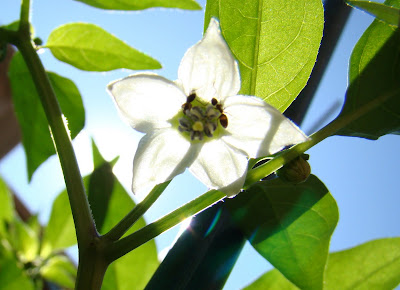
Purple coneflower, Echinacea purpurea, has been a favorite native plant for as long as I can remember. Silly me, when first starting our garden, was lured by some of the coneflower cultivars. I won't tell you how much money I
Goldfinches LOVE coneflower seeds. I'm not thrilled watching them pick off the petals, but I love seeing them come to the garden for the seeds, and the swallowtail butterflies and hummingbirds who enjoy their nectar.

Nodding onions, Allium cernuum, are about to bloom. Monica shared these with me when she came for a visit last summer, along with a few other native plants that are happily settling into our garden. The blooms of nodding onions can be pink, white, or lavender. (Ours are white.) They're happy in full to part sun, and are to said not to like hot summers. I'm happy they're doing well here in spite of our weather! All parts of the plant are edible. It's a very nutritious plant that was widely enjoyed by Native Americans and early settlers. The juice is said to make a fine insect repellent. (I'm not sure I'd want my skin to smell like onion juice!)
 This is a young Culver's Root, Veronicastrum virginicum. It had a smaller, single bloom spike last year. This year's one bloom spike is a little bigger, but still not as impressive as the candelabra of spikes it will hopefully have when it's more mature. At about thirty inches, it's also much smaller than it's eventual five-foot mature height. Still, it's a lovely plant. The foliage has stayed fresh all season, and shows no signs of insect damage or any fungus, yellowing, or crisping whatsoever. Culver's Root is visited by many pollinators. You can see a list of them at the Illinois wildflowers website at the link above, where you can also see a photo of the blooms on a mature plant.
This is a young Culver's Root, Veronicastrum virginicum. It had a smaller, single bloom spike last year. This year's one bloom spike is a little bigger, but still not as impressive as the candelabra of spikes it will hopefully have when it's more mature. At about thirty inches, it's also much smaller than it's eventual five-foot mature height. Still, it's a lovely plant. The foliage has stayed fresh all season, and shows no signs of insect damage or any fungus, yellowing, or crisping whatsoever. Culver's Root is visited by many pollinators. You can see a list of them at the Illinois wildflowers website at the link above, where you can also see a photo of the blooms on a mature plant.The roots of Veronicastrum virginicum have a long history of medicinal use by Native Americans, mostly for digestive disorders, and as purifying herb which induces sweating. It's believed the plant is named after Dr. Culver, an American physician and proponent of its medicinal uses in the 17th or 18th century.

Eupatorium purpureum's buds are just starting to turn pink. I divided these plants last spring - not an easy task thanks to their very tough roots. The plants resented having their roots disturbed and looked pretty awful the rest of the season. They've recovered very nicely though this year, although they're not as tall as they were before dividing them. The divisions are doing well in another area of our garden, though so far there are no signs of flower buds.
Also known as Joe Pye Weed, these very large, tall plants are wonderful in the garden. Another native with usefulness as a medicinal plant, they're grown here primarily for their ornamental value and attractiveness to pollinators. They draw lots of different kinds of bees, every butterfly in the neighborhood, and even hummingbirds thanks to their tubular flowers. The pollinator traffic on Joe Pye Weed is truly something to behold.
To see more Wildflower Wednesday posts, please visit Gail at Clay and Limestone, who hosts this celebration of native plants and wildflowers on the 4th Wednesday of each month.






























